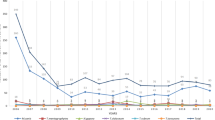Abstract
Tinea capitis is a common dermatophyte infection found in children around the world. WHO notes that 7–33% of children from various age groups are infected with tinea capitis. Some of the problems that are often encountered during treatment are the long treatment time and patient compliance. If not diagnosed and treated properly, this disease can become an epidemic problem. Here we present a 6-year-old boy with kerion type of tinea capitis.
Access provided by Autonomous University of Puebla. Download chapter PDF
Similar content being viewed by others
Keywords
A 6-year-old boy was referred to the Dermatology and Venereology with a reddish nodules on the back of the scalp since three weeks. A severe pruritus and the presence of brittle hairs were reported. Moreover, one week ago, a nodules appeared on the left side of the neck.
A physical examination of the scalp showed well–defined erythematous plaques and nodules with multiple pustules and erosions. Moreover, within the skin lesions multiple broken hairs 0.2–0.5 cm long were present (Fig. 53.1).
Based on the case description and the photographs, what is your diagnosis?
-
1.
Kerion.
-
2.
Furunculosis.
-
3.
Carbuncles.
-
4.
Seborrhoeic dermatitis.
Kerion.
On Wood’s lamp examination, a yellow-green fluorescence was found. A direct mycological examination with 10% potassium hydroxide showed spores outside the hair shaft (ectothrix). In fungal culture, Microsporum canis was isolated.
The patient was diagnosed with kerion. He was treated with systemic microsize griseofulvin 400 mg daily for eight weeks and ketoconazole shampoo 2% two to three times a week.
Discussion
Tinea capitis is often found in children, especially at prepubertal age. Most of the cases (93.3%) occurred below 14 years of age. Symptoms of tinea calitis include itching, fever and pain. The pattern of tinea capitis is divided into: non-inflammatory and inflammatory. Inflammatory tinea capitis is often associated with posterior cervical lymphadenopathy. The lesions may show the kerion form, nodules, broken hair and pustular discharge. The condition can lead to scarring alopecia [1, 2].
In tinea capitis, the source of transmission is an important aspect that needs to be explored. Therefore, it is important to inquire about the history of contact with both humans and animals [3].
A Wood’s lamp examiantion is helpful in diagnosing tinea capitis. A yellow-green fluorescence indicated the presence of Microsporum canis. Dermoscopy is a frequently used method for diagnosing pigmented lesions. In recent years many studies have shown the usefulness of dermoscopy in the evaluation of hair and scalp abnormalities including tinea capitis [4].
Griseofulvin is still recommended for the treatment of tinea capitis in patients over four years of age. It is still the drug of choice because of its safety profile and good tolerance in children. The recommended dose of microsize griseofulvin in children is 20–25 mg/kg/day and ultramicrosize griseofulvin 15 mg/kg/day for six to 12 weeks [5].
Key Points
-
Tinea capitis is a common dermatophyte infection found mainly in children.
-
The diagnosis of tinea capitis is established based on the patient’s history, clinical picture, as well as Wood’s lamp and dermoscopic examination. Griseofulvin is the first-line treatment for tinea capitis in children.
References
Leung AK, Hon KL, Leong KF, Barankin B, Lam JM. Tinea capitis: an update review. Recent Patents Inflamm Allergy Drug Discov. 2020;14:58–68.
Fuller LC, et al. British association of dermatologists guidelines for the management of tinea capitis. BJD. 2014;171:454–63.
Sajjan AG, Mangalgi SS. Clinicomycological profile of tinea capitis in children residing in orphanages. Int J Biol Med Res. 2012;3(4):2405–7.
Hernandez-Bel P, Malvehy J, Crocker A, Sanchez-Carazo JL, Febrer I, Alegre V. Comma hairs: a new dermoscopic marker for tinea capitis. Actas Dermosifilogr. 2012;103(9):836–7.
Craddock LN, Schieke SM. Superficial fungal infection: mycoses, dermatophytes, dermathophytoses. In: Kang S, Amagai M, Bruckner AL, Enk AH, Margolis DJ, McMichael AJ, Orringer JS, editors. Fitzpatrick’s dermatology in general medicine. 9th ed. New York: McGraw-Hill; 2019. p. 2925–51.
Author information
Authors and Affiliations
Corresponding author
Editor information
Editors and Affiliations
Rights and permissions
Copyright information
© 2022 The Author(s), under exclusive license to Springer Nature Switzerland AG
About this chapter
Cite this chapter
Karmila, I.G.A.A.D., Wiraguna, A.A.G.P., Sawitri, P.D. (2022). Kerion in Pediatric Age. In: Waśkiel-Burnat, A., Sadoughifar, R., Lotti, T.M., Rudnicka, L. (eds) Clinical Cases in Scalp Disorders. Clinical Cases in Dermatology. Springer, Cham. https://doi.org/10.1007/978-3-030-93426-2_53
Download citation
DOI: https://doi.org/10.1007/978-3-030-93426-2_53
Published:
Publisher Name: Springer, Cham
Print ISBN: 978-3-030-93425-5
Online ISBN: 978-3-030-93426-2
eBook Packages: MedicineMedicine (R0)





